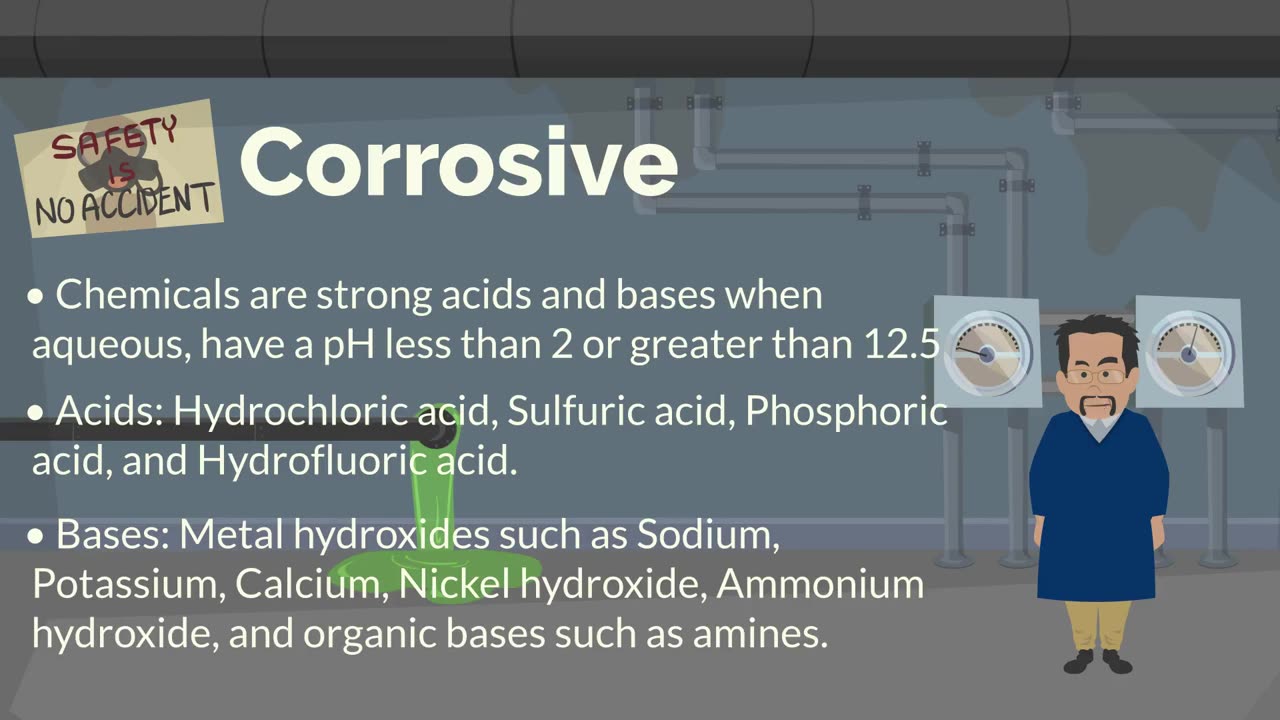Premium Only Content

Chemical Hazard Recognition_ TRIC
**Chemical Hazard Recognition: TRIC**
The acronym **TRIC** can be used as a systematic approach to recognize and address chemical hazards. It stands for **Toxicity, Reactivity, Ignitability, and Corrosivity**. Here's how each component helps in chemical hazard recognition:
---
### **1. Toxicity**
- **Definition**: The potential of a chemical to cause harm to living organisms through inhalation, ingestion, or skin contact.
- **Indicators**:
- Pictograms or labels indicating "Toxic," "Harmful," or "Dangerous."
- Consult the Safety Data Sheet (SDS) for information on lethal doses (LD50) and permissible exposure limits (PEL).
- **Recognition**:
- Examples: Carbon monoxide, cyanide, and pesticides.
- Observe symptoms like dizziness, nausea, or irritation.
---
### **2. Reactivity**
- **Definition**: The chemical's tendency to react violently or release energy when exposed to certain conditions (e.g., heat, water, or other chemicals).
- **Indicators**:
- Terms like "Unstable," "Explosive," or "Reactive" on labels.
- SDS section on stability and reactivity.
- **Recognition**:
- Examples: Sodium reacts with water; peroxides are shock-sensitive.
- Look for storage warnings like "Keep away from heat or incompatible substances."
---
### **3. Ignitability**
- **Definition**: The ability of a chemical to catch fire under certain conditions.
- **Indicators**:
- Flashpoint data on the SDS.
- Flammable or combustible warnings.
- Pictograms like the flame symbol.
- **Recognition**:
- Examples: Gasoline, ethanol, and acetone.
- Check for proper grounding and storage in fire-safe cabinets.
---
### **4. Corrosivity**
- **Definition**: The ability of a chemical to destroy or irreversibly damage materials, including skin and metals.
- **Indicators**:
- Pictograms or warnings indicating "Corrosive."
- SDS sections on handling precautions.
- **Recognition**:
- Examples: Sulfuric acid, sodium hydroxide, and hydrochloric acid.
- Observe physical signs of damage to containers or PPE.
---
### **Application of TRIC in Safety**
1. **Assessment**: Use TRIC to evaluate the potential risks of chemicals during storage, transportation, and usage.
2. **Training**: Educate employees about recognizing hazards and understanding labels and SDS.
3. **Controls**: Implement engineering controls (e.g., fume hoods), administrative controls (e.g., safe work practices), and PPE to mitigate risks.
Would you like this concept expanded into a training presentation or animation script?
-
 6:54
6:54
HSESafetyInformation
1 month ago6 Must Try Breakfast recipes By Food Fusion
341 -
 2:11:58
2:11:58
The Quartering
4 hours agoTrump's Job Market EXPLODES, Bill Burr Runs, Matt Walsh Triggers , Leftist Attacks My Company
164K82 -
 1:06:15
1:06:15
Sean Unpaved
4 hours agoColorado Set To Host NFL Showcase, Last Final Four Predictions, & Bracket Challenge Update!
43.8K1 -
 1:23:40
1:23:40
Ben Shapiro
4 hours agoEp. 2173 - FALLOUT: Stock Market Drops, Trump Pushes On
66.8K57 -
 58:57
58:57
Crypto Power Hour
9 hours ago $0.48 earnedKnow Your Coins, ‘In Crypto We Trust |EP10
12.6K3 -
 2:06:49
2:06:49
Tim Pool
5 hours agoHas Welfare DESTROYED US Culture & The Family? | The Culture War with Tim Pool
168K182 -
 1:55:37
1:55:37
Steven Crowder
7 hours ago🔴 The Friday Show: Fat Pride is Over, California Sucks, and So Does Springsteen (ft. Vince)
394K271 -
 51:57
51:57
The Rubin Report
6 hours agoAndrew Schulz Is Shocked When Dem Mayor Says What No Democrat Will Admit
75.9K40 -
 57:43
57:43
The Big Mig™
4 hours agoGlobal Finance Forum From Bullion To Borders We Cover It All
42.9K7 -
 1:11:32
1:11:32
Rebel News
4 hours ago $3.09 earnedCarney's strawberry servants, Chaos at McGill, Residential school censorship | Rebel Roundup
52.5K6